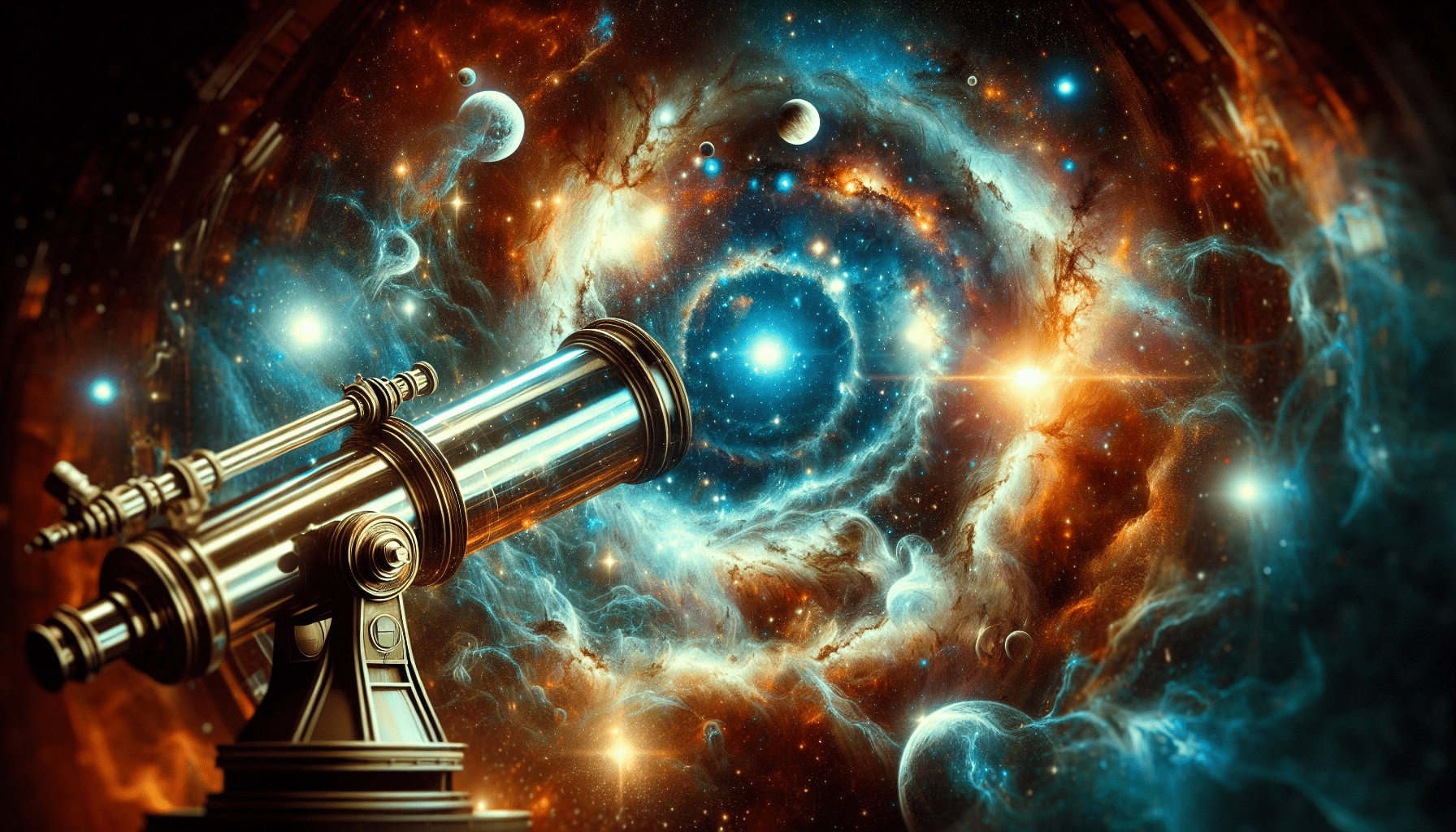Telescopes play a crucial role in aiding scientists to study and understand distant objects that lie beyond the reach of the human eye. By harnessing the power of light and employing intricate optical systems, telescopes allow scientists to observe celestial bodies, such as stars, planets, and galaxies, in great detail. With the ability to capture light that has traveled vast distances through space, telescopes provide researchers with a window into the mysteries of the universe, allowing them to unravel its secrets and expand our knowledge of the cosmos. In this article, we will explore the intricate workings of telescopes and the significant impact they have in bringing scientists closer to distant objects.
Table of Contents
How Telescopes Bring Scientists Closer to Distant Objects

Understanding Telescopes
Telescopes have been instrumental in expanding our knowledge of the universe and have revolutionized our understanding of the cosmos. They enable scientists to observe and study celestial objects that are millions or even billions of light-years away. Understanding the different types of telescopes and their unique capabilities is crucial for conducting astronomical research.
Optical Telescopes
Optical telescopes are perhaps the most well-known type of telescopes. These instruments use lenses or mirrors to gather and focus visible light, allowing astronomers to observe the universe with their naked eyes. Optical telescopes come in various designs, with reflecting and refracting telescopes being the most common.
Reflecting Telescopes
Reflecting telescopes utilize mirrors to gather and focus light, enhancing the image quality over longer distances. These mirrors collect incoming light and reflect it onto a secondary mirror, which then directs the light toward an eyepiece or a camera. Reflecting telescopes are renowned for their ability to capture distant objects with exceptional clarity and are widely used in both amateur and professional astronomy.
Refracting Telescopes
Contrary to reflecting telescopes, refracting telescopes use lenses to gather and focus light. The primary lens collects the incoming light and bends it to create an image at the focal point. Refracting telescopes are simple in design, making them relatively easy to use and maintain, and they offer excellent image quality. However, the size and weight of refracting telescopes can become limiting factors, restricting their use in certain scientific applications.
Compound Telescopes
compound telescopes, also known as catadioptric telescopes, combine both lenses and mirrors in their design. These telescopes take advantage of the best attributes of both reflecting and refracting telescopes, providing enhanced optical capabilities. Compound telescopes come in various configurations, such as the Schmidt-Cassegrain and the Maksutov-Cassegrain designs, offering a compact and versatile solution for both professional and amateur astronomers.
Radio Telescopes
While optical telescopes are essential for studying visible light, there is much more to the electromagnetic spectrum. Radio telescopes allow astronomers to observe cosmic objects and phenomena that emit radio waves, providing unique insights into the universe. These powerful instruments play a crucial role in advancing our understanding of celestial bodies and their complex interactions.
Importance of Radio Telescopes
Radio telescopes are invaluable tools in astronomy due to their ability to detect and analyze radio waves emitted by a variety of celestial objects, including stars, galaxies, and quasars. By collecting these radio signals and translating them into meaningful data, scientists can uncover the mysteries of the universe in ways that optical telescopes alone cannot achieve. The data collected by radio telescopes helps scientists answer fundamental questions about the structure, composition, and evolution of celestial bodies, furthering our comprehension of the cosmos.
Collecting Radio Waves
Radio waves, unlike visible light, can penetrate dense dust clouds and travel vast distances without being significantly altered. This makes radio telescopes particularly useful for studying distant star-forming regions, active galactic nuclei, and other phenomena that emit radio waves. Radio telescopes typically consist of large parabolic dishes, which act as collectors to capture and focus incoming radio waves. These collected waves are then converted into electronic signals for analysis and interpretation by astronomers.
Interferometry
Radio interferometry is a technique used by astronomers to increase the resolution of the gathered data by combining signals from multiple radio telescopes. By using networks of interconnected telescopes spread across vast distances, astronomers can create interferometers that simulate a much larger aperture than a single telescope could achieve. This enables researchers to capture high-resolution images and gather more detailed information about the celestial objects being observed.
Space Telescopes
space telescopes have revolutionized the field of astronomy by overcoming the limitations imposed by the Earth’s atmosphere. By positioning observatories in space, scientists can bypass atmospheric distortion and achieve unprecedented clarity and precision in their observations. These remarkable instruments have opened new doors to exploration and have provided us with exceptional insights into the universe.
Benefits of Space Telescopes
The main advantage of space telescopes is their ability to observe celestial objects without the detrimental effects of the Earth’s atmosphere. The atmosphere can distort and blur light, limiting the resolution and clarity of ground-based telescopes. Space telescopes, on the other hand, can capture images in the ultraviolet, X-ray, and infrared regions, filling in gaps in our understanding of the universe. Additionally, space telescopes can continuously observe a target without interruptions caused by weather conditions or sunlight.
Different Types of Space Telescopes
There have been several notable space telescopes that have played significant roles in expanding our understanding of the cosmos. One of the most renowned is the Hubble Space Telescope, launched in 1990. Hubble has yielded breathtaking images and made groundbreaking discoveries, revolutionizing our knowledge of stellar evolution, galaxy formation, and the expansion of the universe. Other notable space telescopes include the Chandra X-ray Observatory, the Spitzer Space Telescope, and the James Webb Space Telescope (JWST), which is set to launch in the near future.
Hubble Space Telescope
The Hubble Space Telescope has been an icon of scientific discovery and has provided astronomers with unprecedented views of the universe. Its location above the Earth’s atmosphere has allowed it to capture stunning images and gather valuable data across a wide range of wavelengths. The Hubble Space Telescope’s observations have reshaped our understanding of numerous astrophysical phenomena, including distant galaxies, planetary systems, supernovae, and black holes. Its contributions to the field of astronomy are immeasurable.
Enhancing Observations
While telescopes are remarkable tools in their own right, advancements in technology continually strive to improve their capabilities and overcome existing limitations. Several techniques and technologies have been developed to enhance observations and extract more valuable data from the observations obtained by telescopes.
Adaptive Optics
Adaptive optics is a technology that compensates for the blurring effects of the atmosphere, allowing ground-based telescopes to obtain sharper images. By using deformable mirrors and real-time wavefront analysis, adaptive optics systems can measure and manipulate the incoming light to correct for atmospheric distortions. This technology has significantly improved the resolution and image quality of ground-based telescopes, enabling scientists to observe celestial objects with greater clarity and detail.
Aperture Synthesis
Aperture synthesis is a technique used in radio astronomy to achieve high-resolution images using multiple radio telescopes. By combining signals received from separate telescopes at different locations, aperture synthesis mimics the effects of a larger aperture, resulting in sharper images. This technique has proven to be highly successful in producing detailed maps of radio sources, such as galaxies and quasars. Aperture synthesis has played a significant role in advancing our understanding of the universe by providing valuable insights into the structure and behavior of celestial objects.
Multiple Observations
In many cases, multiple observations of the same celestial objects are necessary to gather comprehensive data and derive more accurate conclusions. By observing an object at different wavelengths or over extended periods, scientists can obtain a more complete picture of its properties and behavior. Multiple observations also allow for the identification and analysis of temporal variations, such as changes in brightness or the occurrence of transient events. Combining data from multiple observations is a powerful technique that enhances our understanding of the complex nature of celestial objects.

Scientific Discoveries
Telescopes have been an immense source of scientific discoveries throughout history, enabling us to study celestial bodies and unravel the secrets of the universe. These remarkable instruments provide a wealth of information that expands our knowledge and challenges our understanding of the cosmos.
Studying Celestial Bodies
Telescopes have played a crucial role in studying various celestial bodies, including stars, galaxies, nebulae, and planets. They have allowed scientists to observe the birth, evolution, and death of stars, providing insights into their composition, temperature, and distance. Telescopes have revealed the intricate structures of galaxies and their interactions, shedding light on the processes that shape and govern the universe. Through detailed observations of planets within our solar system, telescopes have helped unravel the mysteries of planetary atmospheres, magnetic fields, and geological formations.
Unraveling the Universe’s Secrets
Telescopes have played a pivotal role in unraveling some of the universe’s most profound and elusive secrets. By observing distant supernovae, astronomers have discovered evidence for the accelerated expansion of the universe, leading to the discovery of dark energy. Telescopes have also allowed scientists to investigate the nature of dark matter by analyzing its gravitational effects on visible matter and studying its distribution throughout the cosmos. These discoveries have fundamentally altered our understanding of the composition and dynamics of the universe.
Origin and Evolution of Stars
Telescopes have been instrumental in studying the formation and evolution of stars. By observing stellar nurseries, astronomers have observed the birth of stars and gained insights into the conditions and processes involved in their formation. Telescopes have also allowed scientists to study the life cycles of stars, from their early stages as protostars to their explosive deaths as supernovae or the peaceful transition into white dwarfs. The observations and data collected by telescopes have provided valuable information about the processes that drive stellar evolution and shape the properties of galaxies.
Dark Matter and Dark Energy
The understanding of dark matter and dark energy has been a major focus of modern astronomy, and telescopes have played a crucial role in these investigations. These enigmatic components of the universe pose significant challenges to our current understanding of physics and cosmology. Yet, advancements in observational techniques and the use of telescopes have provided important clues and deepened our understanding of these mysterious phenomena.
Distant Objects Reveal Clues
Telescopes observing distant objects in the universe have provided essential clues in the search for dark matter and dark energy. By mapping and studying the motions of galaxies within galaxy clusters, scientists have been able to estimate the distribution of dark matter in these systems. These observations have revealed that the visible matter alone cannot account for the gravitational forces at play and have strongly suggested the existence of a substantial amount of dark matter. Additionally, measurements of the cosmic microwave background, which is the remnants of radiation from the early universe, have allowed scientists to infer the presence of dark energy.
Examining Galaxy Cluster Formation
Telescopes have been crucial in examining the formation and evolution of galaxy clusters, which are among the largest structures in the universe. By studying the distribution of galaxies and the intergalactic medium within these clusters, astronomers have gained insights into the role of dark matter in their formation. The observations of gravitational lensing, the bending of light due to the gravitational pull of massive objects, have provided further evidence for the presence of dark matter within galaxy clusters. These observations have contributed to our understanding of the hierarchical growth of structure in the universe and the role of dark matter in this process.
Understanding the Universe’s Expansion
One of the most profound discoveries in modern astrophysics is the accelerated expansion of the universe. Telescopes observing distant supernovae have played a crucial role in uncovering this phenomenon. The observations revealed that the distant supernovae were fainter than expected, indicating that the universe is expanding at an accelerating rate. This unexpected result led to the hypothesis of dark energy, a mysterious force responsible for this acceleration. Through subsequent observations and measurements, telescopes have continued to refine our understanding of dark energy and its implications for the fate of the universe.

Probing Exoplanets
In recent years, the search for exoplanets, or planets beyond our solar system, has captured the attention of both astronomers and the general public. Telescopes have been instrumental in identifying and characterizing these distant worlds, providing valuable insights into the diversity of planetary systems and the potential for habitable environments.
Characterizing Exoplanets
Telescopes equipped with specialized instruments have offered glimpses into the characteristics of exoplanets, such as their size, mass, and orbital parameters. By observing the periodic dimming of a star’s light as an exoplanet passes in front of it, astronomers can determine the size and shape of the exoplanet’s orbit. Additionally, telescopes can detect the wobble of a star caused by the gravitational pull of an orbiting exoplanet, allowing scientists to estimate its mass. These observations and measurements contribute to our understanding of exoplanetary systems and their formation.
Searching for Habitable Worlds
One of the primary goals in the search for exoplanets is to identify potentially habitable worlds, capable of supporting liquid water and potentially life. Telescopes have played a significant role in this endeavor by detecting exoplanets within their star’s habitable zone, where conditions may be suitable for the existence of liquid water. The Kepler Space Telescope, for example, has identified numerous exoplanets located within this zone, providing a foundation for future studies on the potential habitability and the presence of life beyond Earth.
Identification of Exoplanet Atmospheres
Telescopes have also contributed to the study of exoplanet atmospheres, providing insights into their composition and properties. By analyzing the light passing through an exoplanet’s atmosphere as it transits in front of its host star, astronomers can detect the presence of certain molecules and gases. Telescopes equipped with spectrographs can analyze the spectrum of the starlight that has passed through the exoplanet’s atmosphere, revealing signatures of specific elements or compounds. These observations help scientists understand the atmospheric conditions and potential habitability of exoplanets.
Mapping the Cosmos
Telescopes have enabled us to map and explore the vast cosmic landscape, providing detailed views of galaxies, clusters, and the intricate web of structures that make up the universe. Through extensive surveys and observations, astronomers can create comprehensive maps that offer insights into the distribution of matter and the large-scale structure of the cosmos.
Charting Cosmic Structure
Telescopes have been indispensable tools in mapping the cosmic structure, allowing researchers to study the distribution of galaxies and galaxy clusters across the sky. Large-scale surveys, such as the Sloan Digital Sky Survey, have provided precise measurements of the positions, distances, and properties of millions of galaxies. These surveys have revealed the existence of cosmic filaments, vast networks of galaxies that form interconnected structures over billions of light-years. The observations made by telescopes have helped trace the cosmic web, providing a deeper understanding of the evolution of the universe.
Observing Distant Galaxies
By observing distant galaxies with telescopes, astronomers can explore the evolution of galaxies and gain insights into the early stages of the universe. Telescopes capable of observing in the near-infrared and submillimeter wavelengths have been particularly instrumental in studying the most distant and ancient galaxies. These observations allow scientists to observe galaxies as they were billions of years ago, providing a glimpse into their formative stages and the processes responsible for their growth and evolution. Telescopes have also detected gravitational lensing effects caused by massive galaxies, allowing astronomers to study even more distant and faint objects.
Mapping the Cosmic Microwave Background
The cosmic microwave background (CMB) is the remnant radiation from the Big Bang, and observing it has been crucial in understanding the early universe. Telescopes designed specifically to measure the CMB have provided detailed maps of this faint radiation across the sky. These maps have revealed tiny fluctuations in the CMB, representing the seeds of structure that eventually led to the formation of galaxies and galaxy clusters. By precisely measuring the properties of these fluctuations, telescopes have helped refine our understanding of the composition, age, and geometry of the universe.

Future Technological Advancements
The field of telescope technology is continuously evolving, driven by the desire to explore further and observe the universe with unprecedented detail. Advancements in telescope design, instrumentation, and data analysis techniques hold promising prospects for future breakthroughs in our understanding of the cosmos.
Giant Segmented Mirror Telescopes
The development of giant segmented mirror telescopes represents a significant leap forward in telescope design and manufacturing. These telescopes feature large primary mirrors composed of numerous smaller segments that work together to create a larger light-collecting surface. By utilizing advanced computer control systems and precise alignment mechanisms, segmented mirror telescopes can achieve exceptional image quality and resolution. Projects such as the Thirty Meter Telescope and the Giant Magellan Telescope are poised to revolutionize observational astronomy by offering unprecedented views and collecting capabilities.
Next-Generation Space Telescopes
Following in the footsteps of the Hubble Space Telescope, next-generation space telescopes promise to further revolutionize our understanding of the universe. The James Webb Space Telescope (JWST), set to launch in the near future, will be the most powerful telescope ever sent into space. Equipped with advanced instruments capable of observing in the infrared spectrum, the JWST will provide breathtaking views of the early universe, exoplanetary systems, and other astronomical phenomena. These next-generation space telescopes will open new windows of observation, enabling us to delve even deeper into the mysteries of the cosmos.
Advanced Data Analysis Techniques
As telescopes continue to produce vast amounts of observational data, advanced data analysis techniques become increasingly crucial. Modern data analysis methods, such as machine learning and artificial intelligence algorithms, allow astronomers to extract meaningful information from complex datasets. These techniques help identify patterns, classify objects, and uncover hidden correlations that might otherwise be missed. The implementation of advanced data analysis techniques ensures that telescopes can extract the maximum scientific value from their observations, propelling our understanding of the universe to new heights.
In conclusion, telescopes play a vital role in advancing our understanding of the cosmos. Optical telescopes allow for the observation of visible light, while radio telescopes enable the detection of radio waves. Space telescopes, free from the Earth’s atmosphere, provide unparalleled clarity and precision. Through these instruments, scientists can enhance their observations using techniques such as adaptive optics and interferometry.
Telescopes have enabled significant scientific discoveries, including the study of celestial bodies, dark matter, and dark energy, as well as the exploration of exoplanets and mapping of the cosmos. The future holds exciting advancements, such as giant segmented mirror telescopes, next-generation space telescopes, and advanced data analysis techniques, which will further expand our understanding of the universe and uncover new marvels.
Related site – Scientists Say: Telescope
